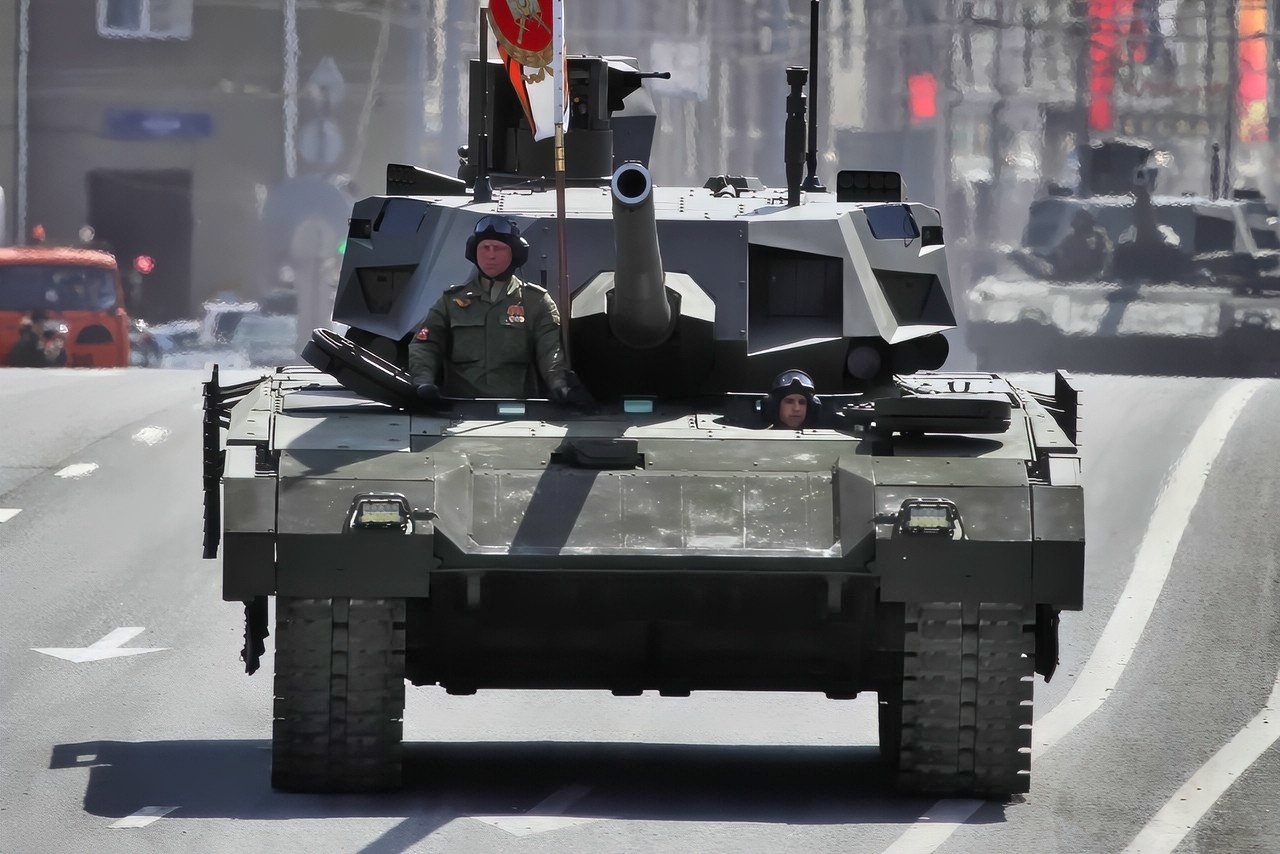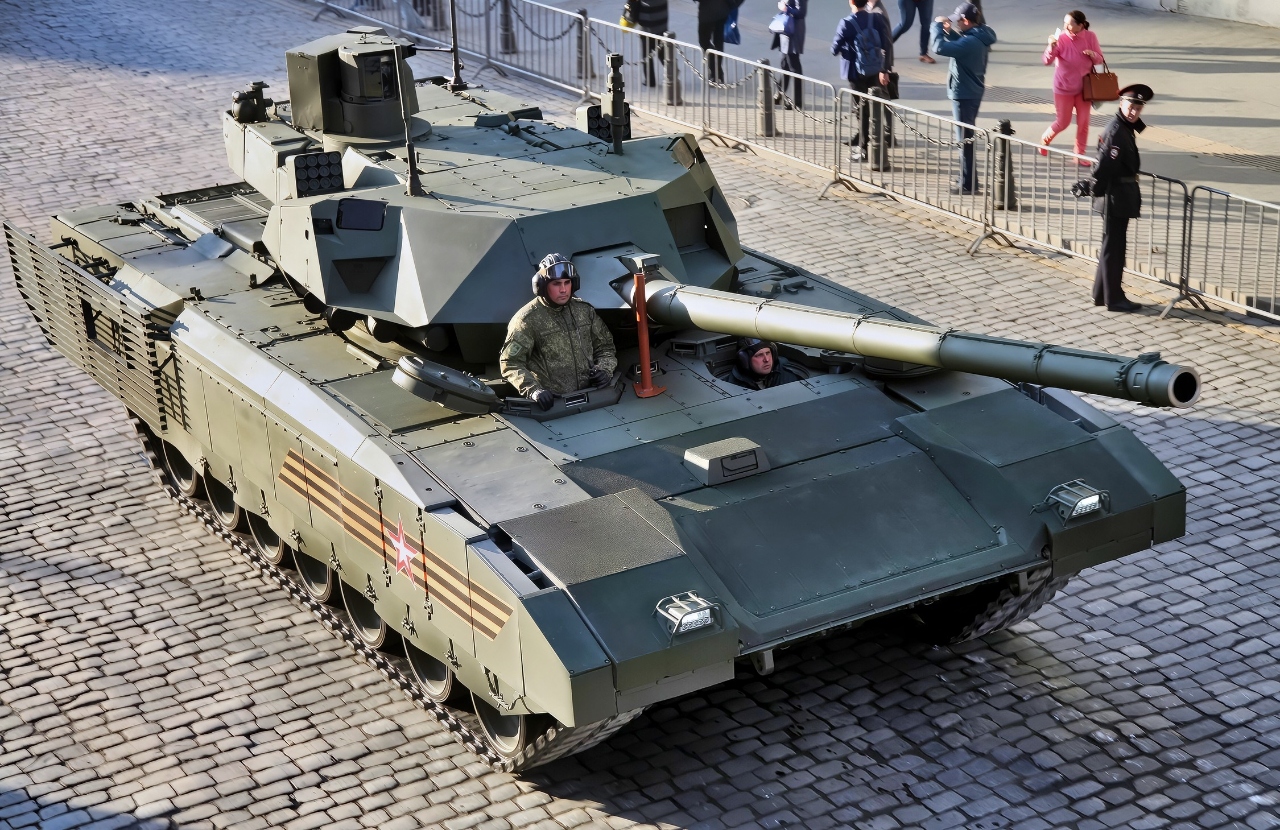Key Points and Summary – Russia’s T-14 Armata, unveiled with fanfare in 2015, has become “the tank that never arrived.”
-A decade later, the ambitious next-generation platform, featuring an unmanned turret and advanced armor, has not entered frontline service.

T-14 Armata. Image Credit: Creative Commons.

Main battle tank T-14 object 148 on heavy unified tracked platform Armata. Image Credit: Creative Commons.
-The program has been crippled by exorbitant costs, unreliable components, and a failure to establish mass production.
-Western sanctions cut off access to vital electronics, forcing Moscow to upgrade older tanks instead.
-Russian officials now admit the T-14 is simply “too expensive” for combat, exposing the deep limitations of Russia’s defense industry.
Russia’s T-14 Armata: The Tank That Never Arrived
When the T-14 Armata was revealed to the world in 2015 on Red Square in Moscow, it was billed as Russia’s big leap into a new generation of armored warfare. It was a significant break from Soviet-era designs.
However, ten years later, Russia has built only a handful of T-14s, and none are in regular frontline service.
The tank that was meant to redefine Russian armor has instead exposed the limits of Moscow’s defense industry – as well as high costs, unreliable components, and production lines that struggle to scale beyond prototypes.
The news should come as no surprise, particularly as the decade has seen Russia battle numerous significant sanctions imposed by the West. Nonetheless, the story is particularly revealing.
The development of the Armata platform began around 2010 under Uralvagonzavod and related design bureaus, as Russia sought to build a universal combat platform that would include new-generation tanks, improved infantry fighting vehicles, new self-propelled artillery, and support vehicles.
The T-14 was designed to replace, over time, several older Russian tanks, including the T-72, T-80, and T-90.
The tank’s public debut came during the 70th Anniversary Victory Day parade on May 9, 2015 – though one of the vehicles broke down or stalled during the event. The high-profile unveiling, however, still helped raise expectations domestically and overseas, with the world expecting a new generation of Russian main battle tank design in the coming years. But it did not pan out as expected.
Planned Design Features and Upgrades
The T-14 design incorporates several advanced features that are rarely seen in Russian tanks.
For example, the tank included an unmanned turret and crew capsule.
The three-man crew (commander, gunner, and driver) is housed in an armored capsule at the front of the hull, separate from the turret and ammunition storage.
A new “Afghanit” active protection system (APS) was also designed to detect and intercept incoming anti-tank missiles and rockets.

T-14 Armata Tank from Russia. Image Credit: Creative Commons.
New composite and reactive armor have been developed to enhance survivability, featuring reactive armor designs that explode upon impact, effectively pushing incoming projectiles away from the vehicle as it strikes.
In terms of power, the T-14 is powered by a diesel engine – the A-85-3A or one of its variants. Russian sources suggested that the engine would deliver 1,500 horsepower, providing the vehicle with respectable mobility for its class.
Its sensors, networking, and situational awareness were all intended to be enhanced as well. Russian claims include sophisticated sensors, battlefield networking, and a “radar” element integrated into the APS to assist with scanning and responding to threats.
Together, the design choices were intended to leapfrog conventional Russian tanks and bring them to parity with the West’s modernized, digitally enhanced main battle tanks, which dramatically improved automation and protection, while also enhancing the potential for modular upgrades.
Realizing the vision, however, proved difficult in the early days—and increasingly problematic as the years passed.
Testing, Production Limits, and Sanctions
From early testing, the T-14 ran into issues with reliability, component durability, and performance under stress.
Cost was also a significant problem for the project, with multiple sources estimating that the per-unit cost was in the range of millions of dollars—dramatically more than what the Russian defense budget could actually support.
Among the cascading problems Russia experienced with the project was the fact that a proper automated assembly line was reportedly never built for the T-14.
To date, many of the prototypes have been hand-assembled, akin to luxury vehicles rather than tanks designed for mass production. Some funds were reportedly allocated to build the line, but the infrastructure never materialized.
And then there are the sanctions. Following Russia’s 2014 annexation of Crimea, sanctions have limited the country’s ability to build advanced components, microelectronics, optical systems, and more. By losing access to foreign-sourced technologies, the program was forced to adapt or substitute domestically-produced components, often imperfectly. With these obstacles, the original plans to build thousands of T-14s between 2015 and 2020 began to fall apart quickly.
Rather than attempt to make the program work, the Russian military pivoted, prioritizing cheaper upgrades to its existing T-72, T-80, and T-90 fleets.

Russian T-90 Tank. Image Credit: Creative Commons.
Some recent statements from Russian officials have hinted at limited production or deliveries, although these instances have all come with caveats. Rostec CEO Sergei Chemezov previously acknowledged some deliveries, for example, but said Russia might not deploy them to Ukraine.
And in other remarks, Chemezov acknowledged that the T-14 is simply “too expensive” to send into Combat, arguing that T-90s are a more efficient choice.
Even though the T-14 has not shifted the balance on the battlefield and has not been fielded at all, let alone built in the numbers Russia really needs, it is still an essential and notable example of Russia’s military-industrial intentions
Should Russia solve its part procurement problems – whether that’s through sanctions evasion, new domestic manufacturing, or deals with other nations – then it’s possible the T-14 will eventually see combat. In fact, it’s likely; after all, Russia needs new main battle tanks and can’t rely on its aging fleet of T-series tanks forever.
However, for now, the T-14 is a good example of how Western sanctions can work—and how war could still ultimately weaken Russia in the long term.
About the Author:
Jack Buckby is a British author, counter-extremism researcher, and journalist based in New York. Reporting on the U.K., Europe, and the U.S., he works to analyze and understand left-wing and right-wing radicalization, and reports on Western governments’ approaches to the pressing issues of today. His books and research papers explore these themes and propose pragmatic solutions to our increasingly polarized society. His latest book is The Truth Teller: RFK Jr. and the Case for a Post-Partisan Presidency.
More Military
SR-72 Darkstar: The Mach 6 Mothership for the F-35 and F-47
China’s J-20 Mighty Dragon Fighter Can Be Summed Up In Just 4 Simple Words
The MBT-70 Tank Still Haunts the U.S. Army
Russia’s ‘New’ MiG-35 Fighter Is Officially ‘Circling the Drain’










